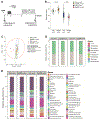CYP eicosanoid pathway mediates colon cancer-promoting effects of dietary linoleic acid
- PMID: 37273180
- PMCID: PMC10283155
- DOI: 10.1096/fj.202300786R
CYP eicosanoid pathway mediates colon cancer-promoting effects of dietary linoleic acid
Abstract
Human and animal studies support that consuming a high level of linoleic acid (LA, 18:2ω-6), an essential fatty acid and key component of the human diet, increases the risk of colon cancer. However, results from human studies have been inconsistent, making it challenging to establish dietary recommendations for optimal LA intake. Given the importance of LA in the human diet, it is crucial to better understand the molecular mechanisms underlying its potential colon cancer-promoting effects. Using LC-MS/MS-based targeted lipidomics, we find that the cytochrome P450 (CYP) monooxygenase pathway is a major pathway for LA metabolism in vivo. Furthermore, CYP monooxygenase is required for the colon cancer-promoting effects of LA, since the LA-rich diet fails to exacerbate colon cancer in CYP monooxygenase-deficient mice. Finally, CYP monooxygenase mediates the pro-cancer effects of LA by converting LA to epoxy octadecenoic acids (EpOMEs), which have potent effects on promoting colon tumorigenesis via gut microbiota-dependent mechanisms. Overall, these results support that CYP monooxygenase-mediated conversion of LA to EpOMEs plays a crucial role in the health effects of LA, establishing a unique mechanistic link between dietary fatty acid intake and cancer risk. These results could help in developing more effective dietary guidelines for optimal LA intake and identifying subpopulations that may be especially vulnerable to LA's negative effects.
Keywords: colon cancer; cytochrome P450 monooxygenase; epoxy octadecenoic acids (EpOMEs); linoleic acid; lipidomics; precision health.
© 2023 Federation of American Societies for Experimental Biology.
Conflict of interest statement
Figures







References
-
- Holman RT Biological activities of and requirements for polyunsaturated acids. Progress in the Chemistry of Fats and other Lipids 9, 607–682 (1971).
-
- Simopoulos AP, Leaf A & Salem N Jr. Essentiality of and recommended dietary intakes for omega-6 and omega-3 fatty acids. Ann Nutr Metab 43, 127–130 (1999). - PubMed
-
- Choque B, Catheline D, Delplanque B, Guesnet P & Legrand P Dietary linoleic acid requirements in the presence of alpha-linolenic acid are lower than the historical 2 % of energy intake value, study in rats. Br J Nutr 113, 1056–1068 (2015). - PubMed
Publication types
MeSH terms
Substances
Grants and funding
LinkOut - more resources
Full Text Sources
Molecular Biology Databases

